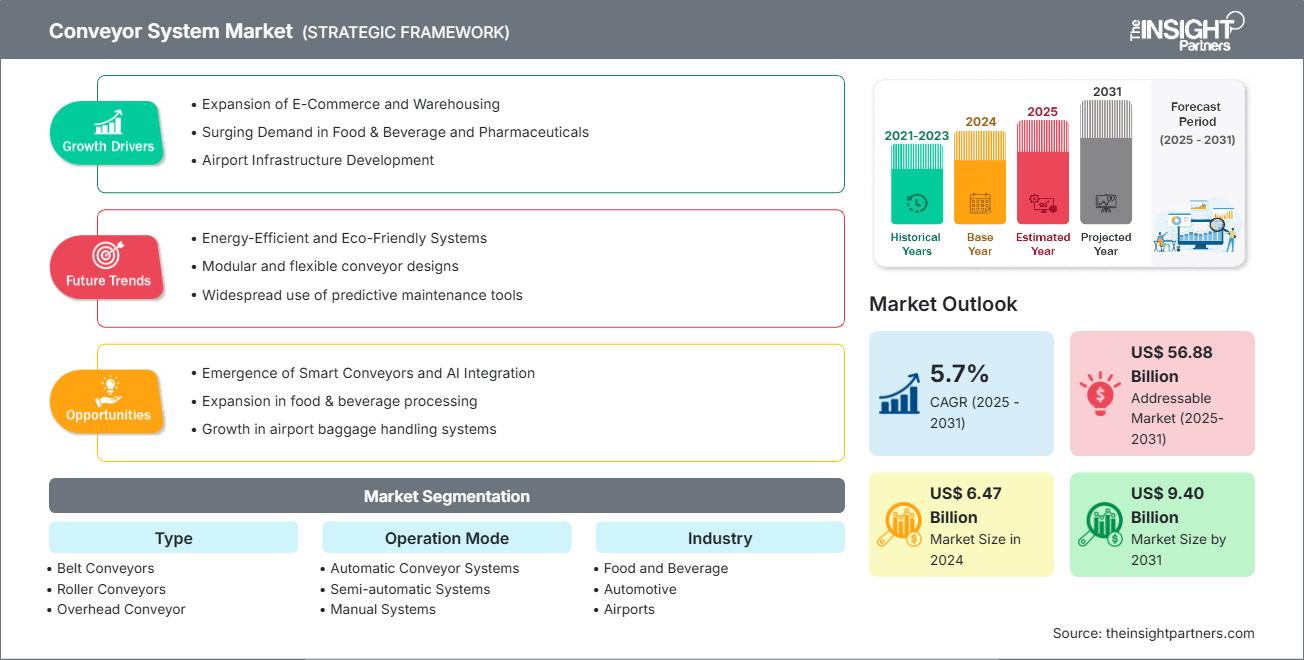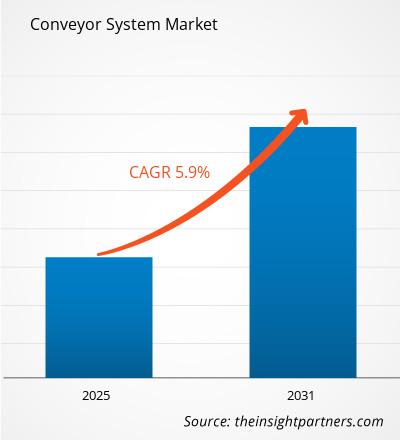预计到 2031 年,输送系统市场规模将从 2024 年的 64.7 亿美元增至 94 亿美元。预计该市场在 2025 年至 2031 年期间的复合年增长率为 5.7%。
输送系统市场分析由于工业自动化程度的提高、电子商务的扩张以及制造设施的现代化,全球输送系统市场一直稳步增长。随着供应链变得越来越复杂和对时间敏感,输送系统对于顺畅的物料流动和流程效率至关重要。推动需求的主要行业包括汽车、食品和饮料、制药、物流和机场。由于工业化的快速发展,亚太地区占据了市场主导地位,而北美和欧洲紧随其后,对传统系统进行了稳步升级,并日益采用智能技术。输送系统市场概览
输送系统是一种机械处理解决方案,用于在设施内将物料从一个点移动到另一个点。这些系统广泛应用于制造业、仓储业、食品加工、采矿业和机场等行业。它们有多种类型,包括带式输送机、滚筒式输送机和高架输送机,用于运输不同形状、尺寸和重量的货物。输送系统通过自动化重复性任务、减少人工劳动和最大限度地缩短处理时间来提高运营效率。
您将免费获得任何报告的定制,包括本报告的部分内容,或国家级分析、Excel 数据包,以及为初创企业和大学提供超值优惠和折扣
输送系统市场: 战略洞察

-
获取本报告的主要市场趋势。这个免费样本将包括数据分析,从市场趋势到估计和预测。
输送系统市场驱动因素和机遇
市场驱动因素:
-
电子商务和仓储的增长:
电子商务的快速增长已成为全球输送系统市场扩张的关键催化剂。随着数字化应用的加速和消费者偏好的演变,在线购物活动的激增迫使企业增强其仓储和配送基础设施,优先考虑可扩展性、速度和运营效率。 -
食品饮料和制药行业需求激增:
食品饮料 (F&B) 和制药行业正在经历显著增长,直接影响对自动化输送系统的需求。随着这些行业扩大运营规模以满足不断增长的全球需求,对高效、卫生和高速物料搬运解决方案的需求变得至关重要。
市场机遇:
-
智能输送机和人工智能集成的兴起:
集成人工智能 (AI) 的智能输送机的兴起为输送系统市场带来了变革机遇。随着各行各业专注于自动化、效率和预测性维护,机器学习、计算机视觉、自然语言处理 (NLP) 和机器人流程自动化 (RPA) 等人工智能驱动的技术正在彻底改变输送系统。
输送系统市场分为不同的细分市场,以便更清楚地了解其运作方式、增长潜力和最新趋势。以下是行业报告中使用的标准细分方法:
按类型:
-
带式输送机:
带式输送机使用连续的皮带将物料从一个地方运送到另一个地方。 -
滚筒输送机:
滚筒输送机由许多相邻放置的滚筒组成,使物品能够平稳地在其上移动。 -
滚筒输送机:
高架输送机悬挂在天花板或支撑结构上,将产品在地面上方移动。 -
其他:
“其他”类别包括螺旋输送机、振动输送机和气动输送机。
按操作模式:
-
自动输送系统:
自动输送系统是全自动机器,无需人工即可移动产品或物料帮助。 -
半自动系统:
半自动传送系统结合了自动化和手动操作。有些任务是自动完成的,而其他任务仍然需要人工输入。 -
手动系统:
手动传送系统完全依靠人力来移动物品。这些系统包括简单的滚轮或轨道,工人可以通过它们将产品从一个点推到另一个点。
按行业:
- 食品和饮料
- 汽车
- 机场
- 物流
- 金属和采矿
- 其他
每个行业类型对传送系统都有特定的要求。这会影响对速度、便利性和可持续性的关注。
按地理位置:
- 北美
- 欧洲
- 亚太地区
- 南美和加勒比地区中美洲
- 中东和非洲
The Insight Partners 的分析师已详尽阐述了预测期内影响输送系统市场的区域趋势和因素。本节还讨论了北美、欧洲、亚太地区、中东和非洲以及南美和中美洲的输送系统市场细分和地域分布。
输送系统市场报告范围
| 报告属性 | 细节 |
|---|---|
| 市场规模 2024 | US$ 6.47 Billion |
| 市场规模 2031 | US$ 9.40 Billion |
| 全球复合年增长率 (2025 - 2031) | 5.7% |
| 历史数据 | 2021-2023 |
| 预测期 | 2025-2031 |
| 涵盖的领域 |
By 类型
|
| 覆盖地区和国家 |
北美
|
| 市场领导者和主要公司简介 |
|
输送系统市场参与者密度:了解其对业务动态的影响
输送系统市场正在快速增长,这得益于终端用户需求的不断增长,而这些需求的驱动因素包括消费者偏好的演变、技术进步以及对产品优势的认知度的提升。随着需求的增长,企业正在扩展产品线,不断创新以满足消费者需求,并抓住新兴趋势,从而进一步推动市场增长。

- 获取 输送系统市场 主要参与者概述
按地区划分的输送系统市场份额分析
亚太地区的输送系统市场正在增长,这主要得益于电子商务行业的扩张。南美和中美、中东和非洲的新兴市场也为输送系统供应商提供了扩展业务的尚未开发的机会。
由于各国电子商务和仓储行业的扩张,每个地区的输送系统市场增长各不相同。以下是按地区划分的市场份额和趋势摘要:
1. 北美
-
市场份额:
占全球市场的很大份额 -
关键驱动因素:
- 汽车、食品和机械制造等行业的强大工业基础饮料和制造业。
- 劳动力成本上升和熟练劳动力短缺正在推动自动化。
- 电子商务和高速物流运营的增长。
-
趋势:
城市微型配送中心出现紧凑、模块化的传送系统。
2.欧洲
-
市场份额:
得益于早期严格的欧盟法规,市场份额巨大 -
关键驱动因素:
- 成熟的汽车和食品加工行业正在采用精密自动化。
- 严格的安全和环境法规促进了先进的输送机解决方案。
- 工业 4.0 技术的采用和遗留系统的改造日益增多。
-
趋势:
采用节能驱动器和配备传感器的系统,实现可持续性和预测性维护。
3.亚太地区
-
市场份额:
增长最快的地区,占据主导市场份额 -
关键驱动因素:
- 中国、印度、越南和东南亚的快速工业化。
- 政府主导的制造业和自动化计划推动了采用。
- 电子商务和仓储基础设施的增长。
-
趋势:
转向模块化、高吞吐量的输送系统以实现物流自动化。
4.南美和中美洲
-
市场份额:
虽然规模较小,但增长迅速 -
关键驱动因素:
- 扩大采矿、农业和散装物料处理业务。
- 物流基础设施和仓储设施的现代化。
- 通过自动化降低人工成本的压力。
-
趋势:
使用自动化传送系统开发区域整合中心。
5.中东和非洲
-
市场份额:
市场稳步增长 -
关键驱动因素:
- 物流、机场和制造业的工业和基础设施大型项目。
- 提高自动化程度以解决劳动力限制并提高效率。
- 仓储和物流区的公共和私人投资。
-
趋势:
在工业区部署定制输送系统的本地合作伙伴关系不断增长。
高市场密度和竞争
由于大福株式会社、凯傲集团和美卓奥图泰等老牌企业的存在,竞争非常激烈。区域性和利基供应商,如 Swisslog Holding AG(德国)和 Fives SAS (法国)加剧了各地区的竞争格局。
这种激烈的竞争促使公司通过提供以下产品脱颖而出:
- 输送系统投资
- 节能环保系统。
机遇和战略举措
- 智能输送机和人工智能集成的出现。
- 越来越重视可持续性。
- 大福株式会社 - 日本大阪
- 凯傲集团股份公司 - 德国法兰克福
- 美卓奥图泰公司 - 芬兰赫尔辛基
- 霍尼韦尔国际公司 - 美国北卡罗来纳州夏洛特
- 英特诺控股有限公司 -瑞士圣安东尼诺
- Fives SAS –法国巴黎
- SSI SCHAEFER 集团 –德国诺因基兴
- Swisslog Holding AG –瑞士布克斯
- TGW Logistics Group GmbH –奥地利韦尔斯
- Vanderlande Industries BV –荷兰费赫尔
免责声明:以上公司排名不分先后。
研究过程中分析的其他公司:
- Dorner Mfg. Corp.
- FlexLink(Coesia 旗下公司)
- Hytrol Conveyor Company, Inc.
- mk Technology Group
- LEWCO, Inc.
- Wynright Corporation(Daifuku 旗下公司)
- FMH Conveyors
- Ashworth Bros., Inc.
- Chantland-MHS
- Vecoplan, LLC
- DynaCon (Dynamic Conveyor Corporation)
- Neuhaus Neotec GmbH
- Schnaithmann Maschinenbau GmbH
- Eaglestone Equipment
- Bunting Magnetics Co.
- Kalitta Air
-
利勃海尔正在密西西比州图珀洛建造一个新的物流中心——
胜斐迩负责提供内部物流解决方案。作为系统集成商,胜斐迩提供全自动内部物流解决方案,包括高架仓库和穿梭车仓库、输送系统以及 SAP 扩展仓库管理 (EWS),以实现高效透明的仓库运营。
-
Coop 和胜斐迩通过广泛的 WAMAS 升级加强合作伙伴关系。
国际生产和零售企业瑞士 Coop 集团与全球领先的整体内部物流解决方案提供商 SSI SCHAEFER 之间的合作正在迈向新的高度:通过订购 WAMAS 内部物流软件的广泛版本升级,Coop 集团对其内部物流运营中同质、面向未来的软件环境充满信心。
《输送系统市场规模和预测(2021-2031)》报告对市场进行了详细的分析,涵盖以下领域:
- 输送系统市场规模以及涵盖范围内所有关键细分市场的全球、区域和国家/地区层面的预测
- 输送系统市场趋势以及市场动态,例如驱动因素、限制因素和关键机遇
- 详细的 PEST 和 SWOT 分析
- 输送系统市场分析,涵盖关键市场趋势、全球和区域框架、主要参与者、法规和最新市场发展
- 行业格局和竞争分析,涵盖市场集中度、热图分析、知名参与者和输送系统市场的最新发展
- 详细的公司简介
- 历史分析(2 年)、基准年、预测(7 年)及复合年增长率
- PEST和SWOT分析
- 市场规模、价值/数量 - 全球、区域、国家
- 行业和竞争格局
- Excel 数据集
近期报告
客户评价
购买理由
- 明智的决策
- 了解市场动态
- 竞争分析
- 客户洞察
- 市场预测
- 风险规避
- 战略规划
- 投资论证
- 识别新兴市场
- 优化营销策略
- 提升运营效率
- 顺应监管趋势






















 获取免费样品 - 输送系统市场
获取免费样品 - 输送系统市场